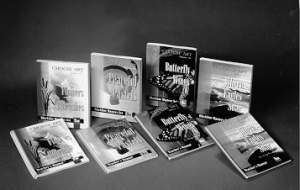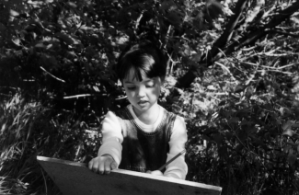

From the Creator of Choose Art
 As the school year begins to wind down, I am happy to report that the Grade One program that many of you have been eager for is well on its way.
While not yet released, it soon will be. Check with your distributor or watch our website for the announcement that Make Me a Rainbow is available for ordering.
As the school year begins to wind down, I am happy to report that the Grade One program that many of you have been eager for is well on its way.
While not yet released, it soon will be. Check with your distributor or watch our website for the announcement that Make Me a Rainbow is available for ordering.
Since the last newsletter, the rest of our materials have been updated. Now, all of our student materials can be purchased as reproducible blackline masters.
This means, of course, that once you purchase a program, you will have it for keeps, as you can reproduce your own student booklet pages!
Although the initial cost is understandably higher, you will save in the long run.
A blackline masters set includes an updated teacher's manual. The blackline masters and the teacher's manual are being sold as a set because the programshave all been updated; therefore, your old teacher's manual will not exactly match the new blackline masters.
Student booklets are still available individually, but if you switch to blackline masters, you will receive the newly updated teacher's manual when you purchase the set.


Blackline Masters Sets
Grades Two through Five
 top of page top of page
Make Problem Solving Your Goal
In math or spelling, as in most traditional school subjects, the student relies on convergent thinking, which focuses on only one correct asnwer to a problem.
When memorizing the spelling of a word, creativity is hardly desirable. In the arts, however, such divergent thinking is a valuable skill.
Many tasks in life require divergent thinking. Planning a vacation or designing a supper menu are only a couple. Divergent thinking, which focuses on the generating of multiple solutions, is part of the larger skill of problem solving.
Problem solving requires a number of important cognitive skills and includes not only producing ideas but also choosing a solution from among them. Probem solving ability can be developed throught stimulating art assignments. Such assignments require the children to produce numbers of novel ideas and then to make a series of choices in order to complete the project. If we substitute cute craft ideas for real art lessons, we must examine our goals. Are we trying to provide a break from the rigors of academics? Are we responding to the pressure of providing something the children can take home with them? While this kind of art can destroy creativity, a well-planned and carefully structured program can offer, perhaps, the most accessible avenue to creative development in the elementary school program.
 top of page top of page
Question & Answer
Question? - Why is creativity so important? The children seem to enjoy doing crafts even if they all look alike when they are finished?
Answer! - Although children may enjoy going through the motions of a cut and paste project just as they may have enoy the motor activity involved in coloring, we must be diligent in examining the educational value of such experiences. Always judge an art assignment according to the goals of art education: Does it develop problem solving skills, foster expression and creativity, improve visual discrimination skills, enhance the ability to visualize, provide fulfillment throught productivity?
So-called dictated art tells children their own ideas are not good enough and that they need to depend on an adult for any planning or real thinking. It allows for no expression, only copying. There is little fulfillment since the idea was someone else's. And above all, no real thinking skills are required.
In designing assignments, we should try to provide children with an opportunity to affect their world, to create something from nothing, to experiment, and to problem solve. None of these objectives are accomplished through dictated art.
 top of page top of page
Gathering Sounds
The six-year-old student below is participating in an outdoor lesson, entitled, Gathering Sounds, from the Grade One program, Make Me a Rainbow. While they are outdoors, the children gather sounds to take back inside.
They do so by listening carefully to the gentle breeze in the trees, the birds chirping, a car passing by and then recording each of the sounds as uniquie abstract scribble design of their own creation. The designs they create represent the sounds they in the same way that written symbols represent words, except that the child is expected to relate the character of the sound with the character of the scribble design. Besides practicing auditory skills, the children also develop problem sovling skills, using divergent thinking to develop symbols, and choosing a solution from among limitless possibilities.

Gathering Sounds - Grade One
 top of page top of page
"If those who complain that the school art program is a 'frill' would stop to think, they would realize that its aim is not to produce practicing artists so much as thinking people"
- Elizabeth Harrison,
"Perspective: How Necessary is Art?"
 top of page top of page

|